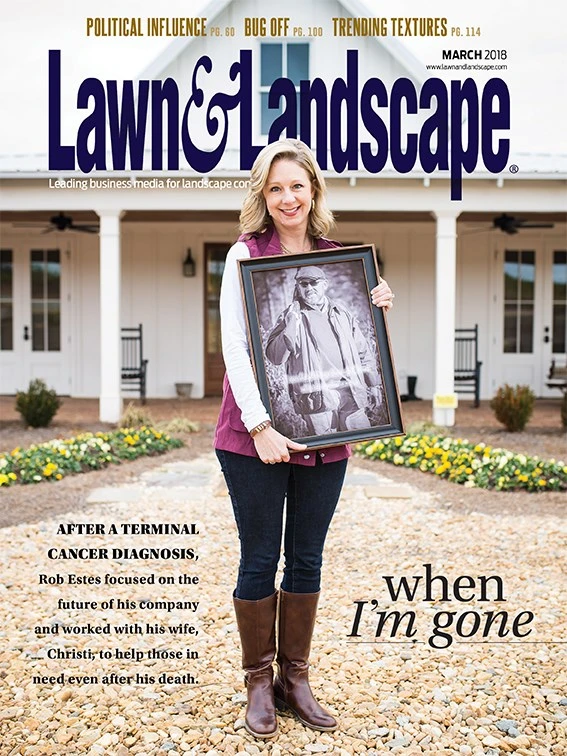
In 2008, they found themselves out of work in the wake of the Great Recession. A few weeks later, they found out they were expecting their first child. They needed to pay bills, but no one was hiring.
A neighbor suggested they start a lawn care service. Luke had previous experience cutting grass for a friend who owned a landscaping business in Michigan, so he knew he could hit the ground running.
They leveraged what they had learned about sales, management, finance and customer service from their old employer to start building a business. It helped that they were surrounded by support: Luke’s brother loaned them $5,000 to buy some used equipment from Craigslist. A friend from their church shared his knowledge from several decades in the industry, and several volunteers from the congregation helped secure the company’s first customers in exchange for a barbecue dinner.
“A big group of people from

Customer-driven growth.
Within the first year, customers began introducing growth opportunities that expanded the company beyond residential lawn care. For example, one man called Hansford out of the blue and presented a list of commercial properties he managed.
“At the time, I just had a small 36-inch mower and a little rig. My trailer was only 6-by-10. I literally had to cut the roof off of it so I could fit it in my garage,” Hansford says. “The guy said, ‘Do you think you can handle these properties?’ and I’m looking at the list like, no way – but I said yes, and I went to a local dealer and got a new trailer, two big mowers, and a whole set of equipment.”
In addition to upgrading his equipment to take on commercial lawn care, Hansford also had to hire his first few employees to supplement the help of friends from church.
Landscape installation services came next. Before the company even had the name Pink and Green Lawn Care and Landscape, Hansford bought the lawncareandlandscape.com domain because “it was available, and it was cheap,” he says. Over time, more calls came in about the second half of the company’s name.
“We started getting calls for landscape installations, and I really had no idea about that,” Hansford says. Luckily, his brother introduced him to someone from his gym who had experience doing landscape installations. He worked with Hansford for about a year to establish the division.
Today, the company is 50/50 residential and commercial, and 50/50 lawn care and landscape installation. Their 50 employees are split evenly between the two service divisions. Luke oversees landscaping (and deals with all the sales), while Lana oversees lawn care (as well as marketing and finance). Pink and Green grew 23 percent last year, achieving about $4 million in revenue.

Memorable branding.
A couple of years into the business, Luke realized that most of the calls were coming from women. “In most cases, the women of the house were dealing with the lawn care, and they would say, ‘I want a healthy, green lawn and I want more color in my yard.’”
From that simple insight, Lana came up with the name Pink and Green Lawn Care and Landscape.
Soon after that, they decided to invest in a new fleet of trucks, as the mechanic costs were adding up
“I wanted to stand out from the sea of lawn trucks driving around South Florida, and it was either pink or green,” Hansford says. “I opted for pink – not very manly, but it stands out.”
“I wanted to stand out from the sea of lawn trucks driving around South Florida, and it was either pink or green.” Luke Hansford, owner, Pink and Green Lawn Care and Landscape
Higher prices and higher value.
The biggest challenge Hansford sees in the lawn care industry is that prices haven’t kept pace with increasing expenses like gas and labor. Perpetuating the problem, some companies bid low just to win work, then end up cutting corners. “What happens is that they don’t charge enough money, so they’re not able to do a good job,” he says. “They get a lot of complaints; they get a lot of
The solution, which Hansford had to learn the hard way, is simply charging more.
“If you are honest, hardworking and do a great job, don’t be afraid to charge for it,” he says. “When we started off, we took on every customer that would have us, but it’s better to have one customer that pays $120 than three customers that pay $40. Once we decided to charge what we really need to (for residential lawn care), we saw that the complaints went down, and customer retention went up.”
Of course, if you raise prices, be prepared to lose customers in the process.
“Every time you go
Customer alignment.
Today, Pink and Green
“(Potential customers) want to walk you around and tell you everything they’re not happy about and everything they want, but the first thing I always ask is, ‘What’s your budget?’” Hansford says. “They can tell you all the things they want, but if the budget doesn’t allow you to actually fix those things, then it’s a waste of time for everybody.”
Hansford designed his sales process around education – not with the goal of closing every sale, but with the goal of finding the right customers.
“We have a specific sales pitch I wrote that’s more of a scary educational pitch than it is a sales
Every customer signs a DocuSign online that states exactly what they’re paying for, what’s included, and what’s not, to avoid surprises.
“We’re not trying to close every customer,” Hansford says. “We’re trying to make sure we sign up good customers who know what they’re getting into and are on the same page.”

Explore the March 2018 Issue
Check out more from this issue and find your next story to read.
Latest from Lawn & Landscape
- Echo secures Sourcewell contract for public agencies
- New AI startup Plantista launches crowdfund for firewise landscaping
- Residential in the rear view
- Harness the Power of Emotion to Attract Lawn Care Clients
- Ignite Attachments introduces tree and fence post puller
- Landscape Workshop acquires 2 in Virginia markets
- Schill Grounds Management acquires Elevations Landscaping
- Central Turf & Irrigation rebrands as Central Pro Supply




